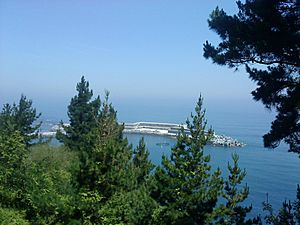Mutriku Breakwater Wave Plant facts for kids
Quick facts for kids Mutriku Breakwater Wave Plant |
|
|---|---|
 |
|
| Country | Spain |
| Location | Mutriku |
| Coordinates | 43°18′43″N 2°22′41″W / 43.3120°N 2.3781°W |
| Construction began | 2006 |
| Commission date | July 2011 |
| Construction cost | €6.4 million |
| Operator(s) | Ente Vasco de la Energía |
The Mutriku Breakwater Wave Plant is a special kind of power plant. It uses the power of ocean waves to make electricity. This plant is located in the bay of Mutriku, a town in Spain. It sits right inside a breakwater, which is a wall built in the sea to protect the harbor from big waves.
This plant is very important because it was the first in the world to be built into a breakwater and use many turbines together. It can make 296 kilowatts (kW) of power. This comes from 16 special machines called turbo generators. The plant started working on July 8, 2011.
Contents
How the Plant Was Built
The Mutriku plant was built by a group called Ente Vasco de la Energía (EVE). This is an energy agency from the Basque region of Spain. They used a technology called oscillating water column (OWC).
Choosing the Technology
The idea for the Mutriku breakwater was finished in 2005. After that, the government asked EVE to design a wave power plant that could fit right into the breakwater. They picked OWC technology because it had been tested before. It was also easy to add into the breakwater's design.
Building the Plant
Construction of the power plant began in 2006. It was built into a 100-meter (about 328 feet) long part of the breakwater. This section was built on a strong foundation.
Inside this section, 16 air chambers were made. These chambers were built using parts that were made beforehand. Each air chamber has an opening that is always under the sea. This lets seawater flow in and out.
When a wave comes, it pushes the water up inside the chamber. This pushes the air out through the top. When the wave goes back down, it pulls air back into the chamber. This moving air spins a special turbine. Each turbine is connected to a generator that makes electricity.
Each of these turbo generator units stands vertically. They are about 2.83 meters (9.3 feet) tall and 1.25 meters (4.1 feet) wide. Each one weighs about 1,200 kilograms (2,645 pounds). Each unit can make 18.5 kW of power. With all 16 units working, the plant can make a total of 296 kW. The company Voith Hydro made all this equipment.
How the Plant Works
The Mutriku power plant officially opened on July 8, 2011. It produces enough electricity to power about 100 homes. This shows how useful wave energy can be.
Power Production Records
In its first five years, the plant sent over 1.3 gigawatt-hours (GWh) of power to the electricity grid. A GWh is a huge amount of electricity!
By 2020, the Mutriku plant had produced a total of 2 GWh. This made it the record holder for the most electricity ever produced by a wave power plant. It also holds the record for the most hours a wave power plant has been running.
Looking at Efficiency
A study in 2018 looked at how well the plant was working. They found that from 2014 to 2016, the plant's "capacity factor" was 0.11. The capacity factor tells you how much power a plant actually makes compared to the most it could possibly make. The researchers thought that if they could control the turbine speeds better, the plant could make even more power.
Protecting the Environment
Since 2016, scientists have been watching the plant closely. They want to see if the sounds it makes underwater affect sea animals. This helps make sure wave power is good for the environment.
See also
 In Spanish: Central undimotriz de Motrico para niños
In Spanish: Central undimotriz de Motrico para niños
- List of wave power stations

